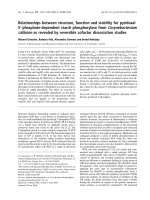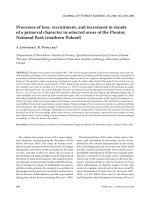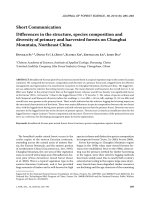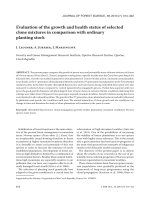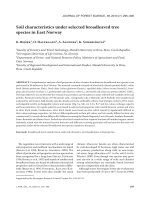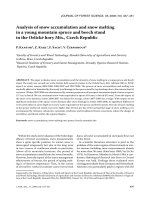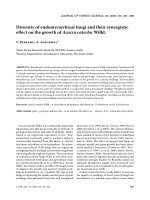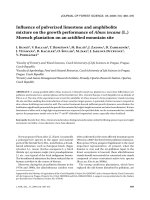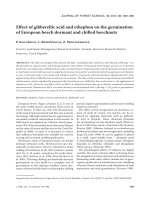Báo cáo lâm nghiệp: " Relationships between browsing damage and woody species dominance" doc
Bạn đang xem bản rút gọn của tài liệu. Xem và tải ngay bản đầy đủ của tài liệu tại đây (236.7 KB, 9 trang )
J. FOR. SCI., 55, 2009 (1): 23–31 23
JOURNAL OF FOREST SCIENCE, 55, 2009 (1): 23–31
e intensity of browsing damage to particular
tree species by ungulates is always dependent on
a broad spectrum of factors. In addition to the
abundance of browsing animals, site properties and
properties of woody species, the species composi-
tion of trees in advance regeneration plays also an
important role (different attractiveness of particular
species) as well as the density of this advance growth
(different amounts of biomass for consumption,
difficult access to seedlings etc.). A markedly selec-
tive character of damage is considered to be quite
characteristic of browsing damage (e.g. E,
B 1989; M 1996; Č, M
2003). anks to the repeated selective browsing
not only delayed natural regeneration occurs but
also marked changes in the species composition
of trees take place (e.g. P 1979; A 1990,
1996; B et al. 1990; M 2003; S
et al. 2005).
With changing intensity of the impact of ungulates
on woody vegetation not only the actual intensity
of damage to trees but also other parameters, e.g.
their mortality (dead/damaged), can change. In ar-
eas with the higher population density of browsing
animals, relatively balanced intensities of damage
to the particular trees are observed. Nevertheless,
food-attractive species show a markedly higher
percentage of mortality. On the other hand, in areas
with lower yet evident load, both the rate of damage
to the particular species and their mortality often
fundamentally differ – with respect to the species
resistance (M 1996). An increase in mortality
can be expected particularly at repeated damage
(E 1978, 1980; F 1992), viz. if brows-
Relationships between browsing damage and woody
species dominance
P. Č, P. H, M. Š, R. M
Faculty of Forestry and Wood Technology, Mendel University of Agriculture and Forestry in Brno,
Brno, Czech Republic
ABSTRACT: e paper analyzes data on browsing damage to food-attractive woody species, viz. Acer campestre, Acer
pseudoplatanus, Acer platanoides, Fraxinus excelsior, Sorbus aucuparia and most often eudominant Fagus sylvatica. e
field survey was carried out in 2005–2007. Analyzed data come from 34 transects at 15 localities in the CR with different
abundance of ungulates (Capreolus capreolus, in some areas also Cervus elaphus or Dama dama). Trees occurring in
natural regeneration under a stand were monitored up to a height of 150 cm and the presence of new browsing damage
was monitored. Differences between the percent of damaged individuals of the given species of a food-attractive woody
species and the percent of damaged individuals of all woody species in the transect as well as the proportion of these
parameters significantly correlate with the dominance of the given species being suitable parameters for the analysis of
a relationship between the intensity of damage and dominance. At the same time, the higher the proportion of
Fagus
sylvatica, the higher the relative intensity of damage to monitored food-attractive species.
Keywords: browsing; dominance; Acer; Fraxinus excelsior; Sorbus aucuparia; Fagus sylvatica
Supported by the Ministry of Education, Youth and Sports of the Czech Republic, Project No. MSMT 6215648902 Forest and
Wood.
24 J. FOR. SCI., 55, 2009 (1): 23–31
ing is repeated during the same growing season.
Food-attractive species with the good potential of
compensation growth are repeatedly damaged most
frequently.
The attractiveness of the particular species to
consumers (and the rate of damage derived from the
attractiveness) is markedly species-specific; never-
theless, it shows considerable variability within the
particular areas being in relation to the species and
structure of the consumer population. e species
composition of advance regeneration (trees are more
intensively searched if they occur in combination
with less attractive species) and the rareness of a spe-
cies or its dominance are often mentioned as factors
affecting searching the woody species by ungulates.
In some cases, damage increases with the relative
proportion of a species, in other cases it increases
with the decreasing proportion of these woody
species in advance regeneration. Both polarities of
relationships are interpretable (S, A
1999). Differences in the rate of pressure of brows
-
ing animals, their food strategy, intensity of tree
competition etc. can be of fundamental importance.
Relationships between dominance and damage are
documented and commented in literature, however,
often without more detailed analysis and statistical
documentation of their significance (e.g. H
1990; A 1996; S, S 2003; S
2005) or they were evidenced only for one tree spe-
cies or particular stand mixture (e.g. P 1986;
D et al. 1991; Č 1998).
In 2005–2007, extensive monitoring of browsing
damage to trees was carried out in areas through
-
out the CR in a wide range of natural conditions.
The objective of the monitoring was to determine
the condition of natural regeneration and its
damage on these particular plots using adapted
methodology including relatively extensive vari-
ability of areas. Nevertheless, a question of the
relationship between the intensity of damage and
the woody species dominance in advance regen-
eration was one of problems of our enormous
interest. Therefore, on the basis of previous ex-
perience, five food-attractive tree species were
selected which occurred on these plots from quite
a negligible up to eudominant proportion, viz. Acer
pseudoplatanus, Acer platanoides, Acer campestre,
Fraxinus excelsior and Sorbus aucuparia. For the
purpose of the analysis of a relationship between
food-attractive and less attractive tree species data
Table 1. Basic characteristics of monitored localities
Locality
Number of
transects
Total area
(m
2
)
Year of
monitoring
Number of game/1,000 ha*
Capreolus
capreolus
Cervus
elaphus
Dama
dama
Ungulates
Litovelské luhy 2 375 2005 63 – 11 21
Vrapač 2 225 2005 98 – 63 56
Brumov 2 600 2005 41 26 – 47
Žákova hora 3 355 2006 40 10 – 20
Razula 1 75 2006 29 8 – 15
Jelení bučina 3 555 2006 20 14 – 19
Bučina pod Františkovou myslivnou 1 300 2006 22 18 – 24
Májová 3 860 2006 88 – 15 30
Pálava 3 240 2007 56 – – 14
Chejlava 3 270 2007 30 8 – 16
Jizerskohorské bučiny 2 450 2007 40 50 50 85
Deblín 5 1,500 2007 65 – – 16
Sedloňovský vrch 2 240 2007 P** P** – **
Trčkov 1 300 2007 16 20 – 24
Černý Důl 1 150 2007 P** P** – **
Total 34 6,495
*According to available data of the game management registration or according to information of the state administra-
tion or a game manager; conversion to ungulates according to Decree No. 491/2002 Gaz., i.e. 1 individual of ungulate =
1 ind. of Cervus elaphus or 2 inds. of Dama dama or 4 inds. of Capreolus capreolus; P – the species is present,**no data
were available
J. FOR. SCI., 55, 2009 (1): 23–31 25
Table 2. Basic overview of results from the particular transects
N
all
pcs/m
2
PD
all
(%)
PD
attrac.
(%)
Fraxinus excelsior Acer campestre Sorbus aucuparia Acer pseudoplatanus Acer platanoides Fagus sylvatica Other species*
N
sp
PD
sp
(%)
D (%)
N
sp
PD
sp
(%)
D (%)
N
sp
PD
sp
(%)
D (%)
N
sp
PD
sp
(%)
D (%)
N
sp
PD
sp
(%)
D (%)
N
sp
PD
sp
(%)
D (%)
N
sp
PD
sp
(%)
D (%)
Litovelské luhy A
175 1.06 44 44 113 35 65 52 63 30 10 30 5
Litovelské luhy B
150 0.71 57 57 71 52 47 69 62 46 10 60 7
Vrapač A
201 2.23 40 38 178 37 89 13 54 6 10 90 5
Vrapač B
107 0.79 58 65 33 55 31 17 65 16 20 90 19 24 58 22 13 8 12
Brumov A
2,719 9.06 9 17 388 9 14 410 26 15 348 14 13 1,537 1 57 36 89 1
Brumov B
1,043 3.48 4 9 284 9 27 741 2 71 18 44 2
Žákova hora A
429 4.79 36 44 233 44 56 178 26 42 18 28 2
Žákova hora B
422 3.43 36 40 25 40 6 394 36 93 3 67 1
Žákova hora C
678 4.08 42 43 635 43 94 43 14 6
Razula
618 8.24 1 4 140 4 23 353 1 57 125 1 20
Jelení bučina A
1,091 7.27 7 5 969 5 89 122 21 11 – – –
Jelení bučina B
710 2.78 3 2 295 2 42 378 2 53 16 6 2 21 19 3
Jelení bučina C
306 2.04 16 16 34 41 11 196 16 64 76 7 25
Bučina pod Fr.
myslivnou
365 1.22 13 23 22 32 6 17 12 5 267 14 73 59 4 16
Májová A
521 2.17 47 70 104 70 20 235 57 45 182 27 35
Májová B
312 1.04 47 61 142 61 46 143 41 46 27 15 8
Májová C
331 1.03 42 62 71 62 21 227 38 69 33 21 10
Pálava A
558 7.17 72 68 104 79 19 30 100 6 291 61 54 133 97 26
Pálava B
242 2.69 83 81 61 87 25 51 88 21 93 74 38 37 95 16
Pálava C
672 8.96 83 83 155 93 23 266 92 40 227 65 34 24 100 3
Chejlava A
1,001 11.21 12 16 50 68 5 348 13 34 340 13 34 253 0 26 10 0 1
Chejlava B
1,414 15.21 6 5 136 22 10 490 5 35 478 4 34 304 2 21 6 83 0
Chejlava C
773 9.29 50 52 627 51 75 25 68 11 121 44 14
Jizerskohorské A
1,312 4.29 8 37 262 37 20 1,023 0 79 27 15 1
Jizerskohorské B
215 1.44 5 19 20 20 9 33 18 15 158 0 74 4 0 2
Deblín A
157 0.52 5 7 15 7 10 73 7 47 69 3 43
Deblín B
249 0.83 13 8 111 8 45 29 16 12 109 18 43
Deblín C
378 1.26 6 21 53 21 14 325 4 86
26 J. FOR. SCI., 55, 2009 (1): 23–31
on the most frequent eudominant species, namely
Fagus sylvatica, were also processed.
MATERIAL AND METHODS
Browsing damage was monitored on transects
3 m wide and 25 to 100 m long. e transect length
was given by the local terrain and stand conditions,
regeneration density etc. Transects were established
in stands where the evidence of natural regeneration
was already apparent. Browsing was evaluated in all
species up to a height of 150 cm. Current damage
was assessed, i.e. damage coming from the past win-
ter and actual growing season. Trees with damaged
terminal shoots or heavy damage to lateral shoots
(more than 20% of shoots damaged) were evaluated
as damaged. In 2005–2007, this monitoring was
realized on more than 60 transects of 20 localities
in the CR. Out of these plots, 34 transects at 15 lo
-
calities were selected and the species mentioned
above were included there. Basic characteristics of
localities are given in Table 1. e plots characterize
a wide range of natural conditions from the 2
nd
to
the 6
th
forest vegetation zone. e following species
occurred in advance growth: Acer pseudoplatanus,
Acer platanoides, Acer campestre, Fraxinus excelsior
and
Sorbus aucuparia and most often just with Fagus
sylvatica (see Table 2). Other species occurred in a
small proportion < 10% (22 transects); in a part of
the plots, there was a very broad spectrum of other
species (6 transects) and in the remaining plots,
Pi-
cea abies or Abies alba (5 transects) and Tilia spp.
(1 transect) showed a significant proportion. As for
ungulates, Capreolus capreolus occurred in all areas.
At two localities, only this species, at 9 localities to-
gether with Cervus elaphus, at 3 localities with Dama
dama and at 1 locality roe deer occurred together
with both the species. Converted abundance of game
(according to Decree No. 491/2002 Gaz.) ranged
from 14 to 85 individuals/1,000 ha (see Table 1).
For each of 34 transects, the following parameters
were determined:
• number of individuals of a species – N
sp
;
• number of individuals of attractive species (5 at
-
tractive species) – N
attrac
;
• number of individuals of all species – N
all
;
• number of damaged individuals of a species
– N
dam
;
• number of damaged individuals of attractive spe
-
cies (5 attractive species) – N
dam attrac.
;
• number of damaged individuals of all species
– N
dam
all
;
• damage to a species in % – PD
sp
= (N
dam
/N
sp
) ×
100;
*In case the abundance of 5 monitored species was lower than 10 pcs, they were included among other species
N
all
pcs/m
2
PD
all
(%)
PD
attrac.
(%)
Fraxinus excelsior Acer campestre Sorbus aucuparia Acer pseudoplatanus Acer platanoides Fagus sylvatica Other species*
N
sp
PD
sp
(%)
D (%)
N
sp
PD
sp
(%)
D (%)
N
sp
PD
sp
(%)
D (%)
N
sp
PD
sp
(%)
D (%)
N
sp
PD
sp
(%)
D (%)
N
sp
PD
sp
(%)
D (%)
N
sp
PD
sp
(%)
D (%)
Deblín D
322 1.07 7 9 159 9 49 163 5 51
Deblín E
331 1.1 12 31 42 31 13 280 10 84 9 11 3
Sedloňovský vrch A
508 5.64 10 42 19 42 4 484 9 95 5 0 1
Sedloňovský
vrch B
110 0.73 15 13 39 13 35 70 16 65 1 0 1
Trčkov
958 3.19 13 43 30 43 3 226 44 24 702 1 73
Černý Důl
778 5.19 10 29 17 29 2 755 10 97 6 0 1
Total
20,156 1,289 485 546 5,314 2,219 8,032 2,271
Table 2 to be continued
J. FOR. SCI., 55, 2009 (1): 23–31 27
• damage to food-attractive species in % – PD
attrac
=
N
dam attrac
/N
attrac
) × 100;
• damage to all species in % – PD
all
= (N
dam all
/N
all
) × 100;
• dominance – D = (N
sp
/N
all
) × 100;
• dominance of attractive species – D
attrac
= (N
attrac
/N
all
) × 100;
• a difference between damage to a species and dam
-
age to all species DifPD = PD
sp
–PD
all
;
• a difference between damage to attractive species and
damage to all species DifPD
attrac
= PD
attrac
–PD
all
;
• the proportion of damage to a species and damage
to all species RPD = PD
sp
/PD
all
;
• the proportion of damage to attractive species and
damage to all species RPD
attrac
= PD
attrac
/PD
all
.
The data were processed using correlation and
regression analysis. e calculation of correlation
coefficients for linear correlations and testing their
significance by Student’s t-test was carried out in
Excel as well as polynomial regression. Correlations
were determined for the particular tree species and
for three aggregate groups of species. e groups of
species were as follows: Fraxinus excelsior + Acer
pseudoplatanus + Acer campestre, the group of the
previous 3 species + Acer platanoides (both combina-
tions of species actually occurred in transects, see Ta
-
ble 2) and the group of all 5 food-attractive species.
RESULTS AND DISCUSSION
Food-attractive tree species
An overview of the results is given in Table 2,
the results of correlation analysis and testing the
significance of correlation coefficients are shown in
Tables 3 and 4.
e percentage of individuals damaged by brows-
ing (PD
sp
) negatively correlated with the number of
individuals of the given species in a transect (N
sp
). A
statistically significant correlation was found out in
Sorbus aucuparia and in all groups of species (Ta-
ble 3). Because the total abundance of species
relatively markedly differed in the particular plots
(minimum 107, maximum 2,719), it is not possible
to consider the simple number of individuals as a
utilizable indicator of the species rarity. us, the
percentage of damaged individuals of a given species
(PD
sp
) also appears to be problematic for analyses.
Assessing the relationship between the intensity of
damage and dominance, PD
sp
was not (in our case) a
suitable parameter representing the rate of search-
ing a woody species by “browsers”. Particular plots
notably differed in their general damage. Damage to
all species (PD
all
) ranged from 4% (Sidonie) to 83%
(Pálava B, C) (see Table 2). us, the same % dam-
age to a monitored woody species is considered as
high on one plot, and on the contrary, as small on
the other plot. To assess the effect of the species
proportion on damage we would have to have plots
roughly of the same PD
all.
Since the rate of damage
is not known in advance, it would take to work with
selection which would have to be carried out from
the enormous amount of plots. For these reasons,
a statistically significant correlation was found out
in our database only in Sorbus aucuparia (Table 3),
which occurred in plots with PD
all
in the rather nar-
row interval of 5–17% (Table 2).
Table 3. Correlation coefficients and their significance – food-attractive species
Tree species
(group of species)
Number of
transects
(items)
Correlation
coefficient –
correlation of N
sp
with PD
sp
Correlation coefficient r – correlation of D with
PD
(% of damaged)
DifPD (differences
PD
sp
and PD
all
)
RPD (rate of PD
sp
and PD
all
)
Acer pseudoplatanus 18 –0.403 –0.173 –0.560 ** –0.471*
Acer campestre 6 0.336 –0.428 –0.553 –0.393
Acer platanoides 10 –0.568 –0.129 –0.652* –0.810****
Fraxinus excelsior 10 –0.591 –0.207 –0.595 –0.526
Sorbus aucuparia 10 –0.691** –0.845**** –0.895**** –0.840****
A. pseudoplatanus +
F. excelsior + A. campestre
34 –0.494**** –0.253 –0.551**** –0.440****
A. pseudoplatanus +
F. excelsior + A. campestre +
A. platanus
44 –0.504**** –0.193 –0.493**** –0.419****
All 5 attractive species
together
54 –0.375**** –0.147 –0.582**** –0.532****
*Coefficient is significant at α = 0.05, **coefficient is significant at α = 0.03, ***coefficient is significant at α = 0.02, ****coef-
ficient is significant at α = 0.01
28 J. FOR. SCI., 55, 2009 (1): 23–31
e difference between damage to a given tree
species and damage to all tree species (DifPD) cor-
related negatively with the dominance of this tree
species; the same relationship was detected for the
proportion of damage (RPD) and dominance. Sta-
tistically significant correlations were determined
for Acer pseudoplatanus, Acer platanoides, Sorbus
aucuparia and for all groups of species (see Table 3).
e same correlations with dominance (D
attrac
) were
also found out for the difference or proportion of
damage to 5 attractive woody species and damage
to all species (DifPD
attrac
and RPD
attrac
) (see Table 4).
Both parameters, i.e. the difference and the propor-
tion, can be considered to be suitable to assess rela-
tionships between the tree species dominance and
the intensity of its damage by browsing.
us, it is possible to note that the relative in-
tensity of damage to food-attractive tree species
increases with their decreasing relative proportion.
Results of regression analysis (Fig. 1) show that the
relationship is rather of polynomial than linear char-
acter. With respect to the character of both param-
eters it is evident that with increasing dominance
the effect of a species on the total damage (PD
all
) also
increases. At high dominances, the difference and
proportion of damage to a species and damage to all
species approaches zero or is close to one.
Statistically significant correlations between dom-
inance or otherwise expressed relative abundance of
a species and the intensity of damage were found out
in the natural regeneration of
Carpinus betulus in
the Moravian Karst (Č 1998) – a statistically
significant negative correlation (r = 0.702, α = 0.05)
between the percentage of damaged individuals and
dominance. P (1986) found out the nega-
tive correlation between damage and dominance
for Pinus sylvestris and Populus tremula in mixed
stands of these two species in Lithuania. D et
al. (1991) found higher browsing damage to Pinus
sylvestris in mixed stands in Sweden as compared
with pure stands or stands where Pinus sylvestris
clearly dominated.
Table 4. Correlation coefficients and their significance – relationships between Fagus sylvatica and food-attractive
species (24 transects)
Parameter
Correlation coefficient r – correlation of the parameter with
dominance of F. sylvatica
dominance of food-attractive
species
PD of Fagus sylvatica (% of damaged) –0.155 –0.069
DifPD of Fagus sylvatica (differences PD
sp
and PD
all
) –0.040 –0.360
RPD of Fagus sylvatica (rate of PD
sp
and PD
all
) –0.340 –0.015
PD
attrac
(% of damaged) 0.184 –0.213
DifPD
attrac
(differences PD
attrac
and PD
all
) 0.533**** –0.632****
RPD
attrac
(rate of PD
attrac
and PD
all
) 0.585**** –0.605****
*Coefficient is significant at α = 0.05, **coefficient is significant at α = 0.03, ***coefficient is significant at α = 0.02, ****coef-
ficient is significant at α = 0.01
Fig. 1. Polynomial dominance of a species (D) with the difference in damage to a given tree species and damage to all species
(DifPD) and the proportion of damage to a given species and damage to all species (RPD)
y = 0.853x
2
– 1.076x + 0.283
R ² = 0.467
-30%
-20%
-10%
0%
10%
20%
30%
40%
50%
60%
0% 20% 40% 60% 80% 100%
D
Differences PDsp and PDall
Differences PD
sp
and PD
all
(%)
0
y = 0.853x
2
– 1.076x + 0.283
R
2
= 0.467
D (%)
y = 6.150x
2
- 8.001x + 3.251
R ² = 0.371
0
1
2
3
4
5
6
0% 20% 40% 60% 80% 100%
D
Rate of PDsp and PDall
Rate of PD
sp
and PD
all
–
0 20 40 60 80 100
y = 6.150x
2
– 8.001x +3.251
R
2
= 0.371
D (%)
J. FOR. SCI., 55, 2009 (1): 23–31 29
Greater damage to species occurring in lower pro-
portion was also noted by P (1986), H-
(1990), A (1996), P (2001), S and
S (2003) or S (2005). However, these
were more or less partial studies and the relationship
between the species proportion and damage was not
tested in detail.
M (1997) demonstrated an opposite re-
lationship, i.e. positive correlation between the spe-
cies proportion and the rate of damage, on data from
an extensive inventory carried out by IFER (Institute
for Forest Ecosystem Research) and IFMP (Institute
for Forest Management Planning) in 1995. e oc
-
currence of browsing damage slightly increased
with the higher proportion of conifers on an area of
4 km
2
, i.e. in the vicinity of the stand. is depend-
ence was most evident in plantations of Picea abies
where it reached statistical significance.
Fagus sylvatica in relation to food-attractive
tree species
No statistically significant relationship was found
out between the dominance of
Fagus sylvatica (D)
and its damage expressed anywise (PD, DifPD, RPD)
(see Table 4). Likewise, no significant relationship
was found between the dominance of food-attrac-
tive woody species (D
attrac
) and damage to Fagus
sylvatica (PD, DifPD, RPD).
In Fagus sylvatica, a negative correlation was
detected between dominance and the percentage
of damaged individuals in the Moravian Karst in
1996 (Č 1998). ese were relatively young
stands, and in subsequent years of monitoring car-
ried out on the same plots the correlation was found
no longer. e situation was explained by changes
in the density of advance regeneration and by its
effect on the intensity and character of damage. In
the course of growing up, beech created fast-grow-
ing clusters of individuals. us, these clusters in
principle impassable were damaged minimally re-
gardless of the proportion of beech. Dense clumps
were damaged only along their periphery, namely
in winter. The relationship between the natural
seeding density and damage to trees is commented
in literature inconsistently. In some cases, trees
were damaged to a larger extent in dense natural
seeding (F 1985), in other cases, by contrast,
particularly in less dense natural seeding (C-
, M 1982). e effects of advance growth
density are also possible in the case of this paper
with respect to differences on particular plots (see
Table 2). Nevertheless, the character of the database
does not make it possible to check the data.
A statistically significant positive correlation was
found between the dominance of
Fagus sylvatica
and damage to attractive tree species expressed as
a difference or proportion with damage to all spe-
cies (DifPD
attrac
, RPD
attrac
) (see Table 4). e higher
the percentage proportions of Fagus sylvatica, the
higher the relative intensity of damage to monitored
food-attractive species. is relation is a logical
complement to correlations commented in the pre
-
vious subchapter.
A relationship between the relative proportions
of differently food-attractive woody species and
their damage by browsing was documented by
E and B (1989) from the Bern canton.
On 199 plots in silver fir/beech stands, the authors
monitored browsing damage by roe deer to the
advance growth of Fagus sylvatica, Acer pseudopla-
tanus, Fraxinus excelsior, Sorbus aucuparia, Abies
alba and Picea abies. In line with our data, they
found that the higher proportion of Acer pseudo-
platanus, Fraxinus excelsior and Sorbus aucuparia
decreased damage to Fagus sylvatica and Picea
abies as well as to Abies alba. In addition, they re-
ported that at the high abundance of Fagus sylvatica
and
Picea abies in advance growth, damage to Abies
alba increased and, vice versa, the high proportion
of Abies alba contributed to higher damage to Fagus
sylvatica and Picea abies.
CONCLUSIONS
e analysis of data of browsing damage monitor-
ing demonstrated that the intensity of damage to
food-attractive woody species increased with their
decreasing relative proportion and increasing pro-
portion of Fagus sylvatica in advance regeneration.
us, with a reduction in the abundance of these
species due to browsing a pressure on their popula-
tions increases, which can result in the acceleration
of their selection and the subsequent impoverish-
ment of the tree species composition. e disap-
pearance of minority species from the stand species
composition has been repeatedly proved.
To analyze the intensity of damage to trees, dam-
age to the given tree species related to the total dam-
age to trees (viz. a difference or the % proportion of
damaged individuals of the given species and % of
damaged individuals of all species) appeared to be
most suitable.
Re fer enc es
AMMER CH., 1990. Auswirkungen des Bestockungswandels
und der Waldschaden auf die Schutzfunktion des Berg
-
30 J. FOR. SCI., 55, 2009 (1): 23–31
waldes gegenüber Schneebewegungen. In SCHUSTER E.J.
(ed.), Zustand und Gefahrdung des Bergwaldes: Ergebnisse
eines Rundgespräches 21. April 1989. Hamburg, Verlag Paul
Parey: 102–111.
AMMER CH., 1996. Impact of ungulates on structure and
dynamics of natural regeneration of mixed mountain forests
in the Bavarian Alps. Forest Ecology and Management,
88: 45–53.
BURSCHEL P., BINDER F., EL KATEB H., MOSANDL R.,
1990. Erkenntnisse zur Walderneuerung in der Bayerischen
Alpen. In SCHUSTER E.J. (ed.), Zustand und Gefahrdung
des Bergwaldes: Ergebnisse eines Rundgespräches 21. April
1989. Hamburg, Verlag Paul Parey: 40–49.
CUMMINS R.P., MILLER G.R., 1982. Damage by red deer
(Cervus elaphus) enclosed inplanted woodland. Scottish
Forestry, 36: 1–8.
ČERMÁK P., 1998. Vliv sudokopytníků na lesní ekosystémy
Moravy. Lesnictví-Forestry, 44: 278–287.
ČERMÁK P., MRKVA R., 2003. Browsing damage to broad-
leaves in some national nature reserves in 2000–2001.
Ekológia (Bratislava), 22: 394–403.
DANELL K., EDENIUS L., LUNDBERG P., 1991. Herbivory
and tree stand composition: moose patch use in winter.
Ecology, 72: 1350–1357.
DANELL K., NIEMELA P., VARVIKKO T., 1991. Moose
browsing on Scots pine along a gradient of plant productiv
-
ity. Ecology, 72: 1624–1633.
EIBERLE K., 1978. Folgewirkungen eines simulierten Wild-
verbisses auf die Entwicklung junger Waldbäume. Schwei-
zerische Zeitschrift für Forstwesen, 129: 757–768.
EIBERLE K., 1980. Methodische Möglichkeiten zum Ver-
ständnis der waldbaulich tragbaren Verbissbelastung.
Schweizerische Zeitschrift für Forstwesen, 131: 311–326.
EIBERLE K., BUCHER H., 1989. Interdependenzen zwischen
dem Verbiss verschiedener Baumarten in einem Plenter-
waldgebiet. Zeitschrift für Jagdwissenschaft,
35: 235–244.
FINĎO S., 1985. Ohrozenie mladých lesných porastov odhry-
zom spôsobovaným jeleňou zverou v Chránenej poľovnej
oblasti Poľana. Folia Venatoria, 15: 33–55.
FINĎO S., 1992. Tolerancia drevín na poškodzovanie odhry-
zom. Lesnictví-Forestry, 38: 379–390.
HORVAT T., 1990. Prehranska ekologia rastlinojede divjadi
kot element sanacije razpadajočich jelovo-bukovih gozdov
v spodnjem montanskem pasu. [Diplomsko delo.] Univerza
v Ljubljani, Biotehniška fakulteta: 80.
MORAVČÍK P, 1997. Faktory ovlivňující rozsah poškození
lesních porostů zvěří. Sborník ze semináře Nové metody
pro hodnocení vlivu zvěře na les, část 5. Jílové u Prahy,
IFER: 1–31.
MOTTA R., 1996. Impact of wild ungulates on forest regen-
eration and tree composition of mountain forests in the
western Italian Alps. Forest Ecology and Management,
88: 93–98.
MOTTA R., 2003. Ungulate impact on rowan (Sorbus au-
cuparia L.) and Norway spruce (Picea abies (L.) Karst.)
height structure in mountain forests in the eastern Italian
Alps. Forest Ecology and Management, 181: 139–150.
PADAIGA V., 1986. Measures for protecting forest stands
from elk damage. Metsanduslikud Uurimused, 21: 26–37.
PAULENKA J., 1986. Vplyv poľovnej zveri na odolnostný
potenciál mladých lesných porastov. Folia Venatoria, 16:
31–50.
PERKO F., 1979. Odnosi med rastlinstvom in rastlinojedo
divjadjo v ekosistemih Snežnižkich gozdov. Pregled go-
jitve in odstrela jelenjadi v lovskem letu 1978. Notranjsko
lovskogojitvenih območij (LGO), Sneznik: 28–38.
PRŮŠA
E., 2001. Pěstování lesa na typologických základech.
Kostelec nad Černými lesy, Lesnická práce: 593.
SENN J., SUTER W., 2003. Ungulate browsing on silver fir
(Abies alba) in the Swiss Alps: belief in search of supporting
data. Forest Ecology and Management, 95: 151–164.
STERGAR M., 2005. Objedenost mladja drevesnih vrst
v odvisnosti od zgradbe sestoja. [Diplomsko delo.] Univerza
v Ljubljani, Biotehniška fakulteta: 70.
STROLE T.A., ANDERSON R.C., 1999. White-tailed
deer browsing: species preferences and implications for
central Illinois forests. NCASI Technical Bulletin, 781:
520–521.
SVOBODA M., NAGEL T., HAHN K., NIELSEN A.B.,
ROŽENBERGAR D., DIACI J., 2005. Co nevíme o ekologii
jedle bělokoré. In: NEUHÖFEROVÁ P. (ed.), Jedle bělokorá
– 2005. Sborník referátů, 31. 10–1. 11. 2005 Srní. Praha,
ČZU v Praze, FLE, katedra pěstování lesů a Správa Národ-
ního parku a chráněné krajinné oblasti Šumava: 9–11.
Received for publication June 21, 2008
Accepted after corrections September 15, 2008
Vztah mezi poškozením okusem a dominancí dřevin
ABSTRAKT: Práce analyzuje data o okusovém poškození potravně atraktivních dřevin Acer campestre, Acer pseudo-
platanus, Acer platanoides, Fraxinus excelsior, Sorbus aucuparia a nejčastěji eudominantní dřeviny Fagus sylvatica.
Terénní průzkum probíhal v letech 2005–2007, analyzovaná data jsou z 34 transektů na 15 lokalitách ČR s různou
J. FOR. SCI., 55, 2009 (1): 23–31 31
Corresponding author:
Doc. Ing. P Č, Ph.D., Mendelova zemědělská a lesnická univerzita v Brně, Lesnická a dřevařská fakulta,
Lesnická 37, 613 00 Brno, Česká republika
tel.: + 420 545 134 119, fax: + 420 545 211 422, e-mail:
početností zvěře (Capreolus capreolus, na některých plochách také Cervus elaphus či Dama dama). Monitorovali
jsme dřeviny do výšky 150 cm v přirozené obnově pod porostem, byla sledována prezence nového poškození okusem.
Rozdíl mezi procentem poškozených jedinců daného druhu potravně atraktivní dřeviny a procentem poškozených
jedinců všech druhů dřevin na transektu a stejně tak podíl těchto parametrů významně negativně korelují s domi
-
nancí daného druhu dřeviny a jeví se jako vhodné parametry pro analýzu vztahu intenzity poškození a dominance.
Zároveň platí, že čím vyšší je zastoupení Fagus sylvatica, tím vyšší je relativní intenzita poškození sledovaných
atraktivních dřevin.
Klíčová slova: okus; dominance; Acer; Fraxinus excelsior; Sorbus aucuparia; Fagus sylvatica
